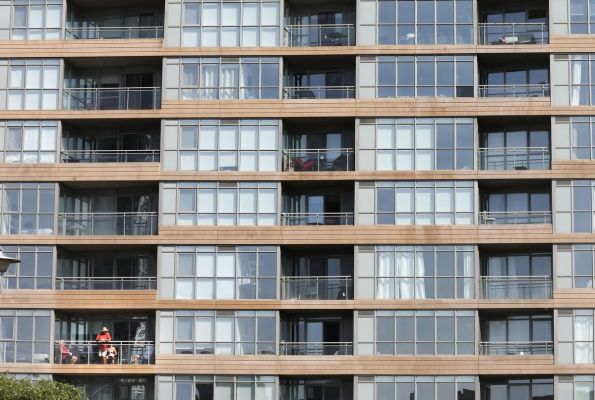Realtor Andrew Harrild is sitting outside the Tip Top Lofts on Lake Shore Blvd. W., looking up at the balconies on the Fort York condos across the street. It’s a blue sky day but there’s not a soul in sight on those tiny, ubiquitous terraces.
“I see a lot of stuff on the balconies but not a lot of people,” says Harrild, a partner in Condos.ca.
More than half his clients put balconies on their condo wish lists. But Toronto’s short summers and the diminutive size of those concrete slabs means that sought-after outdoor space is frequently under-used and often relegated to storage, a repository for cafe tables and bikes.
In a city of shrinking apartment sizes, it’s hard not to wonder why balconies are incorporated in so many new buildings when home buyers might get more use from the same space indoors.
“Could you live here,” tweeted Toronto writer and urbanist Matt Elliott referring to a floor plan for a unit in a waterfront development called Sugar Wharf. It touts a 402 sq. ft. condo, including a 325 sq. ft. interior. The remainder, a 77 sq. ft. balcony, is relatively generous, providing just a little less space than two king mattresses laid end to end.
Even if they recognize the balcony is going to be too small, too overlooked, too hot or too shadowed, people like the idea of that door leading outside, said Harrild.
“In the back of (a condo buyer’s) head, if they’re going to be stuck in a glass box up in the sky they’ve got to have, maybe even subconsciously, some kind of connection to the outside world,” he said.
The balcony “was everything,” when Anne Marie Aikins bought a River City condo off a builder’s plan more than four years prior to moving in last month.
Throughout construction, the spokeswoman for Metrolinx would visit the site to admire her future view of the Don train yard, the Hearn generating station and Corktown Common.
But when she went for a pre-occupancy inspection, Aikins learned that she had misunderstood the position of her unit. The truth — that her balcony not only had a lake view to the southeast, but a stunning downtown vista to the west, including the CN Tower — had her so verklempt, the construction inspector had to leave her alone to recover.
“It was better than I ever imagined,” she said, and Aikins admits she can’t stop tweeting pictures of the views.
The balcony, she says, is especially important because she lives alone.
“There are times when you want to feel connected to your city and other people. Having a spectacular view like that makes you feel like you’re right there in the city with other people. It’s a great way to feel still connected to your city,” she said.
She has decorated her deck with flowers and a pub-height dining set that lets her enjoy the views unobstructed by the railing.
Stephanie Widenoja, who used to co-own a house with a yard, would love to grow plants on her balcony near Bloor and Sherbourne Sts. But the space, just big enough for two facing chairs, is too small.
“When I started looking for a condo I needed to know that I could step outside,” she said. Since then, however, another taller building has gone up next door.
“I feel very exposed when I’m out on my balcony now so I don’t go out a lot. But some days when I’ve been at the desk all day and I get home, it’s nice to sit outside for a half hour or 45 minutes and just breathe some air,” said the IT manager.
Still, Widenoja says she wouldn’t trade the outdoor space for more room inside because some of her guests smoke and she isn’t about to send them down 22 storeys to indulge.
For developers, who sell apartments off building plans and renderings, there is no downside to building balconies, said Capital Developments vice-president Matt Young. The cost — some extra concrete, rebar and railings — is, in the grand scheme of high rise projects, minimal. It certainly costs less than finished interior space, he said.
“I’m not saying you need (balconies) to sell but the business is all about managing risk. So if you’re going into an unknown market and you know that most people would rather have a balcony than not, as long as you can provide it, it’s a lot less risky to sell that way,” said Young.
“Most investors want to see some outdoor space. They don’t necessarily care how much it is, so whether it’s a full-wrapped balcony or a smaller 50 sq. ft. balcony, just the idea of having outdoor space is important. If you’re an end-user, like with anything else, you think in your head how you’re going to live and when reality comes in you might find that’s actually not how I’m living in the space,” he said.
In his previous condos, Young admits his balconies served as a retreat for smokers or private phone conversations. Now he has a ground-floor terrace that he uses for entertaining.
Young figures a balcony has to be at least 5 ft. wide to be useable. At that size, he said, “You’re not going to have a dining room set but you can have a little café table and a few chairs and some planters. If you start getting smaller — 4 ft., 3.5 ft. — that’s where it really just becomes a place where you can open up, go outside, get some fresh air and come back in. You can’t really program that space very well.”
Ontario Association of Architects president John Stephenson sees the psychological advantages outdoor access gives condo dwellers, particularly as the size of apartments seems to be shrinking.
But he says those concrete slabs jutting out from Toronto towers can have a negative environmental impact called thermal bridging.
“The structure that runs from the inside to the outside conducts heat to the exterior,” said Stephenson. “If you imagine these tall buildings that are ringed with balconies these balconies function like big radiator fins. They deliver heat to the outside and impact the overall thermal performance of buildings that are marginal to begin with.
“If we are trying to reduce our carbon footprint and reduce the energy consumption for these buildings — rethinking the balconies would be important,” he said.
A more practical solution might be what Stephenson calls French balconies.
“Think of a French window in Europe with shutters on the outside and big doors on the inside and then a railing so when (it) is open you have a railing between you and falling that is safe. But you are standing on the edge of the heated floor slab,” he said.
Although he says his wife never uses it, Stephen Weir, a sales and marketing manager, spends hours most days reading and putzing on the balcony of their Regent Park condo, where he has a hammock, a chair and planters of veggies and herbs.
If he looks north, there’s a sea of green city trees. To the west, he can watch the city’s development progress.
“The majority of the time spent out there is solo for me,” said Weir. “I just like being out there — the noise and the city — I find it soothing.”
Stephenson likes the idea of common outdoor areas in high rise developments because they have social benefits. But he believes there is room for more creativity in designing private outdoor spaces too.
“The design industry needs to be challenged to come up with new ideas for tall buildings to meet this need,” he said. “The design industry and architects in turn need to challenge their clients to think differently about the design instead of just taking the brief given to them by the developer.”
Tess Kalinowski is a Toronto-based reporter covering real estate.

